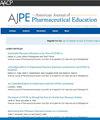Integrating and Assessing Entrustable Professional Activities in Doctor of Pharmacy Curricula
IF 3.8
4区 教育学
Q1 EDUCATION, SCIENTIFIC DISCIPLINES
引用次数: 0
Abstract
Objectives
The 2022 Curriculum Outcomes and Entrustable Professional Activities include an updated set of entrustable professional activities (EPAs) for Doctor of Pharmacy graduates. To assist pharmacy educators with the integration and assessment of EPAs, this work aimed to review and synthesize approaches to integrate EPAs in health professions curricula, strategies for EPA-related assessments and entrustment in health professions curricula, and challenges and research needs for integrating EPAs in assessment frameworks in Doctor of Pharmacy curricula.
Findings
A literature review resulted in 114 articles identified as having relevance with 33 articles specific to pharmacy education. There are multiple components of an effective EPA integration and assessment plan, including administrative leadership, determination of programmatic EPAs with comprehensive descriptions, selection of an entrustment-supervision scale, identification of EPA-based assessments, EPA mapping, data management, and training and development.
Summary
Strategies with applicability for integrating and assessing EPAs in pharmacy education were analyzed and synthesized. Evidence-informed and expert recommendations for EPA integration and assessment are discussed. Programs can apply these recommendations to implement and assess EPAs in alignment with their own institutional and curricular contexts.
整合和评估药学博士课程中可信赖的专业活动。
目标:2022年课程成果和可信赖的专业活动(COEPA)包括一套更新的药学博士毕业生可信赖的专业活动(EPAs)。为了帮助药学教育工作者整合和评估EPAs,本研究的目的是回顾和综合:1)将EPAs整合到卫生专业课程中的方法;2)卫生专业课程中epa相关评估和委托的策略;3)将EPAs整合到药学课程评估框架中的挑战和研究需求。一项文献综述发现114篇文章与33篇关于药学教育的文章相关。有效的EPA整合和评估计划有多个组成部分,包括行政领导,确定具有全面描述的计划性EPA,选择委托监督规模,确定基于EPA的评估,EPA绘图,数据管理以及培训和开发。摘要:分析和综合了适用于药学教育环境评价整合与评估的策略。讨论了EPA整合和评估的证据和专家建议。各课程可以根据自己的机构和课程背景,应用这些建议来实施和评估环境保护措施。
本文章由计算机程序翻译,如有差异,请以英文原文为准。
求助全文
约1分钟内获得全文
求助全文
来源期刊
CiteScore
4.30
自引率
15.20%
发文量
114
期刊介绍:
The Journal accepts unsolicited manuscripts that have not been published and are not under consideration for publication elsewhere. The Journal only considers material related to pharmaceutical education for publication. Authors must prepare manuscripts to conform to the Journal style (Author Instructions). All manuscripts are subject to peer review and approval by the editor prior to acceptance for publication. Reviewers are assigned by the editor with the advice of the editorial board as needed. Manuscripts are submitted and processed online (Submit a Manuscript) using Editorial Manager, an online manuscript tracking system that facilitates communication between the editorial office, editor, associate editors, reviewers, and authors.
After a manuscript is accepted, it is scheduled for publication in an upcoming issue of the Journal. All manuscripts are formatted and copyedited, and returned to the author for review and approval of the changes. Approximately 2 weeks prior to publication, the author receives an electronic proof of the article for final review and approval. Authors are not assessed page charges for publication.

 求助内容:
求助内容: 应助结果提醒方式:
应助结果提醒方式:


